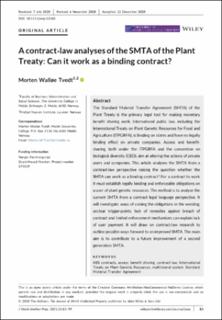| dc.contributor.author | Tvedt, Morten Walløe | |
| dc.date.accessioned | 2021-07-28T07:20:52Z | |
| dc.date.available | 2021-07-28T07:20:52Z | |
| dc.date.created | 2021-02-25T16:21:25Z | |
| dc.date.issued | 2021 | |
| dc.identifier.citation | Journal of World Intellectual Property. 2021, 24 (1-2), 83-99. | |
| dc.identifier.issn | 1422-2213 | |
| dc.identifier.uri | https://hdl.handle.net/11250/2765441 | |
| dc.description.abstract | The Standard Material Transfer Agreement (SMTA) of the Plant Treaty is the primary legal tool for making monetary benefit sharing work. International public law, including the International Treaty on Plant Genetic Resources for Food and Agriculture (ITPGRFA), is binding on states and have no legally binding effect on private companies. Access and benefit‐sharing, both under the ITPGRFA and the convention on biological diversity (CBD), aim at altering the actions of private users and companies. This article analyses the SMTA from a contract‐law perspective raising the question whether the SMTA can work as a binding contract? For a contract to work it must establish legally binding and enforceable obligations on a user of plant genetic resources. The method is to analyse the current SMTA from a contract legal language perspective. It will investigate, ways of coining the obligations in the wording, unclear trigger‐points, lack of remedies against breach of contract and limited enforcement mechanisms can explain lack of user payment. It will draw on contract‐law research to outline possible ways forward to an improved SMTA. The main aim is to contribute to a future improvement of a second generation SMTA. | |
| dc.language.iso | eng | |
| dc.relation.uri | http://dx.doi.org/10.1111/jwip.12180 | |
| dc.title | A contract‐law analyses of the SMTA of the Plant Treaty : can it work as a binding contract? | |
| dc.type | Peer reviewed | |
| dc.type | Journal article | |
| dc.description.version | publishedVersion | |
| dc.source.pagenumber | 83-99 | |
| dc.source.volume | 24 | |
| dc.source.journal | Journal of World Intellectual Property | |
| dc.source.issue | 1-2 | |
| dc.identifier.doi | 10.1111/jwip.12180 | |
| dc.identifier.cristin | 1893804 | |
| dc.relation.project | Norges forskningsråd: 274519 | |
| dc.relation.project | Fridtjof Nansens institutt: 457 | |
| cristin.ispublished | true | |
| cristin.fulltext | original | |
| cristin.qualitycode | 1 | |
